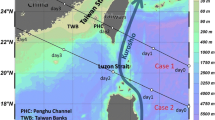Abstract
The Luzon Strait (LS) is a wide channel between Taiwan and the Luzon islands. Eastward of the LS, the Kuroshio Current (KC) flows northward along the eastern coasts of Luzon and Taiwan. A typhoon is a strong and localized low-pressure weather system that occurs frequently in the vicinity of the Taiwan area. One typical typhoon track, passing through the seas surrounding Taiwan, is a zonal path across the LS. The satellite measured SST, corresponding to typhoons Pabuk (5 Aug. 2007–12 Aug. 2007) and Dujuan (29 Aug. 2003–5 Sep. 2003), which both moved along this path, demonstrated that a classic right bias cooling occurs to the north of the storm track, during the typhoon forced period. However, some cold anomaly water also present toward left (south) of the storm track east of the LS in the relaxation period. This paper adopted a three-dimensional hydrostatic primitive equation model to study the possible causes of this southward transport of cold waters. Both model results and the observed SST anomaly revealed that the strength of the upper ocean cooling depends on whether a resonant regime between the typhoon winds and the near-inertial currents can be excited. To the east of the LS, the convergence between the warm Kuroshio water and the cold wakes in the poststorm period will enhance the southward spreading of cold anomaly water. The enhanced vertical mixing, induced by the southward propagation of nearly inertial waves associated with the cold wakes, can also produce some cold anomaly to the south of a storm track in the poststorm period. Both mechanisms can contribute to the occurrence of some cold anomaly water to the south of the storm track east of the KC. To the west of the LS, the convergence between the warm Kuroshio water and the cold upwelling water from the northern South China Sea can further strengthen the Kuroshio front in the LS.












Similar content being viewed by others
References
Cardone VJ, Ross DB, Ahrens MR (1977) An experiment in forecasting hurricane generated sea state. Preprints 11th Tech. Conf. Hurricanes and Tropic Meteorology, Miami Beach. Amer Meteor Soc, pp 688–695
Chern CS, Jan S, Wang J (2010) Numerical study of mean flow patterns in the South China Sea and the Luzon Strait. Ocean Dyn 60:1047–1059
Chu PC, Veneziano JM, Fan C (2000) Response of the South China Sea to tropical cyclone Ernie 1996. J Geophys Res 105(C6):13991–14009
Cione JJ, Uhlhorn EW (2003) Sea surface temperature variability in hurricanes: implications with respect to intensity change. J Phys Oceanogr 131:1783–1796
D’Asaro EA (2003) The ocean boundary layer below Hurricane Dennis. J Phys Oceanogr 33:561–579
Dickey TD, Frye D, McNeil J, Manov D, Nelson N, Sigurdson D, Jannasch H, Siegel D, Michaels A, Johnson R (1998) Upper ocean temperature response to Hurricane Felix as measured by the Bermuda Testbed Mooring. Mon Weather Rev 126:1195–1201
Geisler JE (1970) Linear theory of the response of a two-layer ocean to a moving hurricane. Geophys Fluid Dyn 1:249–272
Holland GJ (1980) An analytic model of the wind and pressure profiles in hurricanes. Mon Weather Rev 108:1212–1218
Jiang X, Zhong Z, Jiang J (2009) Upper ocean response of the South China Sea to Typhoon Krovanh (2003). Dyn Atmos Ocean 47:165–175
Kunze E (1985) Near-inertial wave propagation in geostrophic shear. J Phys Oceanogr 15:544–565
Levitus S (1982) Climatological atlas of the world oceans. NOAA Prof. Paper No. 13, U.S. Government Printing Office, pp 173
Mellor GL, Durbin PA (1975) The structure and dynamics of the ocean surface mixed layer. J Phys Oceanogr 5:718–728
Mitchell DA, Teague WJ, Jarosz E, Wang DW (2005) Observed currents over the outer continental shelf during Hurricane Ivan. Geophys Res Lett 32:L11610. doi:10.1029/2005GL023014
Price JF (1981) Upper ocean response to a hurricane. J Phys Oceanogr 11:153–175
Price JF (1983) Internal wave wake of a moving storm. Part I: scales energy budget and observations. J Phys Oceanogr 13:949–965
Price JF, Sanford TB, Forristall GZ (1994) Forced stage response to a moving hurricane. J Phys Oceanogr 24:233–260
Samson G, Giordani H, Caniaux G, Roux F (2009) Numerical investigation of an oceanic resonant regime induced by hurricane winds. Ocean Dyn 59:565–586. doi:10.1007/s10236-009-0203-8
Semtner AJ (1986) Finite difference formulation of a world ocean model. In Proceedings of the NATO Advanced Study Institute on Advanced Physical Oceanographic Numerical Modelling, ed. By J.J. O’Brien, D. Reidel Publishing Co., Dordrecht, 608 pp
Simons TJ (1978) Generation and propagation of downwelling fronts. J Phys Oceanogr 8:571–581
Tsai YL, Chern CS, Wang J (2008a) The upper ocean response to a moving typhoon. J Oceanogr 64:115–130
Tsai YL, Chern CS, Wang J (2008b) Typhoon induced upper ocean cooling off northeastern Taiwan. Geophys Res Lett 35:L14605. doi:10.1029/2008GL034368
U.S. Department of Commerce, National Oceanic and Atmospheric Administration, National Geophysical Data Center (2001), 5-minute Gridded Global Relief Data (ETOPO5)
Acknowledgements
The National Science Council of Taiwan funded this study under grant NSC98-2611-M-002-015-MY3. The ECMWF model wind data were provided by the Databank of the Institute of Atmospheric Sciences, National Taiwan University.
Author information
Authors and Affiliations
Corresponding author
Additional information
Responsible Editor: Roger Proctor
Rights and permissions
About this article
Cite this article
Kuo, YC., Chern, CS., Wang, J. et al. Numerical study of upper ocean response to a typhoon moving zonally across the Luzon Strait. Ocean Dynamics 61, 1783–1795 (2011). https://doi.org/10.1007/s10236-011-0459-7
Received:
Accepted:
Published:
Issue Date:
DOI: https://doi.org/10.1007/s10236-011-0459-7




